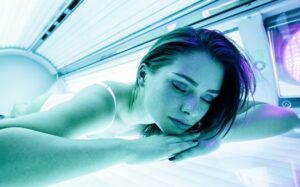A Simple Guide for Long-Lasting Results So, you’ve got your hands on Melanotan 2 (MT2)…

Can Sunbeds help your mental health?
### Get a Glow & Boost Your Mood with Sunbeds 🌞✨
Sunbeds can do more than give you a tan all year round—they can actually boost your mood and help with mental health too! By emitting UV light, sunbeds can help raise your vitamin D levels, potentially easing symptoms of Seasonal Affective Disorder (SAD) and giving you an energy lift.
In this guide, we’ll dive into how sunbeds can mimic the effects of natural sunlight, the benefits of UV light for your body and mind, and how to use sunbeds responsibly for maximum positive impact.
—
### How Much Sun Do We Really Need? ☀️
According to expert research, just 5–10 minutes of sunlight exposure can generate a good dose of vitamin D. But here’s the catch: your body breaks down vitamin D fairly quickly, especially during the gloomy winter months.
Natural sunlight has different kinds of UV rays: UVA, UVB, and UVC. Luckily, our atmosphere filters out the dangerous UVC, leaving us with UVA (which gives us that golden tan) and UVB (which helps our bodies produce vitamin D). This is where sunbeds come in! By using UV light in a controlled setting, they can help boost your vitamin D levels and mood—perfect when sunlight’s in short supply.
—
### The Mental Health Benefits of Sunbeds 💆♂️
#### 1. **Mood Boost**: Indoor tanning mimics the effects of the Mediterranean sun, releasing serotonin—the “feel-good” hormone that helps regulate mood, appetite, and sleep. This can help stave off SAD and other mood dips, especially in the winter.
#### 2. **Stress Relief**: Sun exposure reduces stress hormones like adrenaline, making you feel calmer. While a sunny vacay is great, a sunbed can offer similar relaxation benefits closer to home, plus a dose of endorphins (your body’s natural “happy hormones”).
#### 3. **Immune Support**: Vitamin D helps support your immune system by boosting white blood cells, which means fewer chances of catching that seasonal flu. Regular but moderate sunbed sessions may help keep you healthier, too.
—
### Smart, Safe Sunbed Use 😎
Sunbeds can offer real benefits, but it’s important to use them wisely. Here’s a quick guide to getting the best results while staying safe:
– **Know Your Skin**: Consult with salon experts to find the right tanning time for your skin type, and never go beyond the recommended limit to avoid burns.
– **Watch Out for Meds**: Some medications, like antibiotics and antidepressants, can make your skin extra sensitive to UV light. Always check with your doctor if you’re on medication.
– **Seek Balance**: Sunbeds are great for a quick mood boost but shouldn’t be a sole fix for mental health issues. If you’re struggling, it’s best to talk to a therapist or healthcare professional for additional support.
—
### FAQs: Sunbeds & Mental Health
**Does Vitamin D help with mental health?**
Yes! Studies show that vitamin D can help manage stress, anxiety, and SAD. It’s key to both physical and mental well-being.
**Do sunbeds help you make vitamin D?**
Yes, UVB rays from sunbeds trigger vitamin D production. Just 20 minutes on a sunbed can give you a similar vitamin D boost as 30 minutes in natural sunlight.
**Do sunbeds improve mental health?**
Research is ongoing, but early studies suggest that UV light may boost serotonin levels, offering short-term mood improvements.
Sunbed tanning aids
The use of tanning accelerators and items such as Melanotan 2, Tanning Nasal Sprays and Tanning injection alternatives help speed up the process of acheiving the perfect tan in record time
In short, sunbeds are more than just a beauty tool—they can help keep you feeling good all winter long. Just remember to use them responsibly! 🌞

Information sources
Campbell, P. D., Miller, A. M., & Woesner, M. E. (2017). Bright Light Therapy: Seasonal Affective Disorder and Beyond. The Einstein Journal of Biology and Medicine : EJBM, 32, E13–E25. https://www.ncbi.nlm.nih.gov/pmc/articles/PMC6746555/
Cicarma, E., Porojnicu, A. C., Lagunova, Z., Dahlback, A., Juzeniene, A., & Moan, J. (2009). Sun and Sun Beds: Inducers of Vitamin D and Skin Cancer. Anticancer Research, 29(9), 3495–3500. https://ar.iiarjournals.org/content/29/9/3495
Heckman, C., Darlow, S., Cohen-Filipic, J., & Kloss, J. (2016). Mood changes after indoor tanning among college women: associations with psychiatric/addictive symptoms. Health Psychology Research, 4(1). https://doi.org/10.4081/hpr.2016.5453
Holick, F. M. (2010). The Vitamin D Solution : a Three-step Strategy to Cure Our Most Common Health Problem. Scribe Publications Pty Ltd.
Holick, M. F. (2004). Sunlight and vitamin D for bone health and prevention of autoimmune diseases, cancers, and cardiovascular disease. The American Journal of Clinical Nutrition, 80(6), 1678S1688S. https://doi.org/10.1093/ajcn/80.6.1678s
Kaushal, M., & Magon, N. (2013). Vitamin D in pregnancy: A metabolic outlook. Indian Journal of Endocrinology and Metabolism, 17(1), 76–82. https://doi.org/10.4103/2230-8210.107862
Makrani, A. H., Afshari, M., Ghajar, M., Forooghi, Z., & Moosazadeh, M. (2017). Vitamin D and fibromyalgia: a meta-analysis. The Korean Journal of Pain, 30(4), 250. https://doi.org/10.3344/kjp.2017.30.4.250
Urashima, M., Segawa, T., Okazaki, M., Kurihara, M., Wada, Y., & Ida, H. (2010). Randomized trial of vitamin D supplementation to prevent seasonal influenza A in schoolchildren. The American Journal of Clinical Nutrition, 91(5), 1255–1260. https://doi.org/10.3945/ajcn.2009.29094



This Post Has 0 Comments